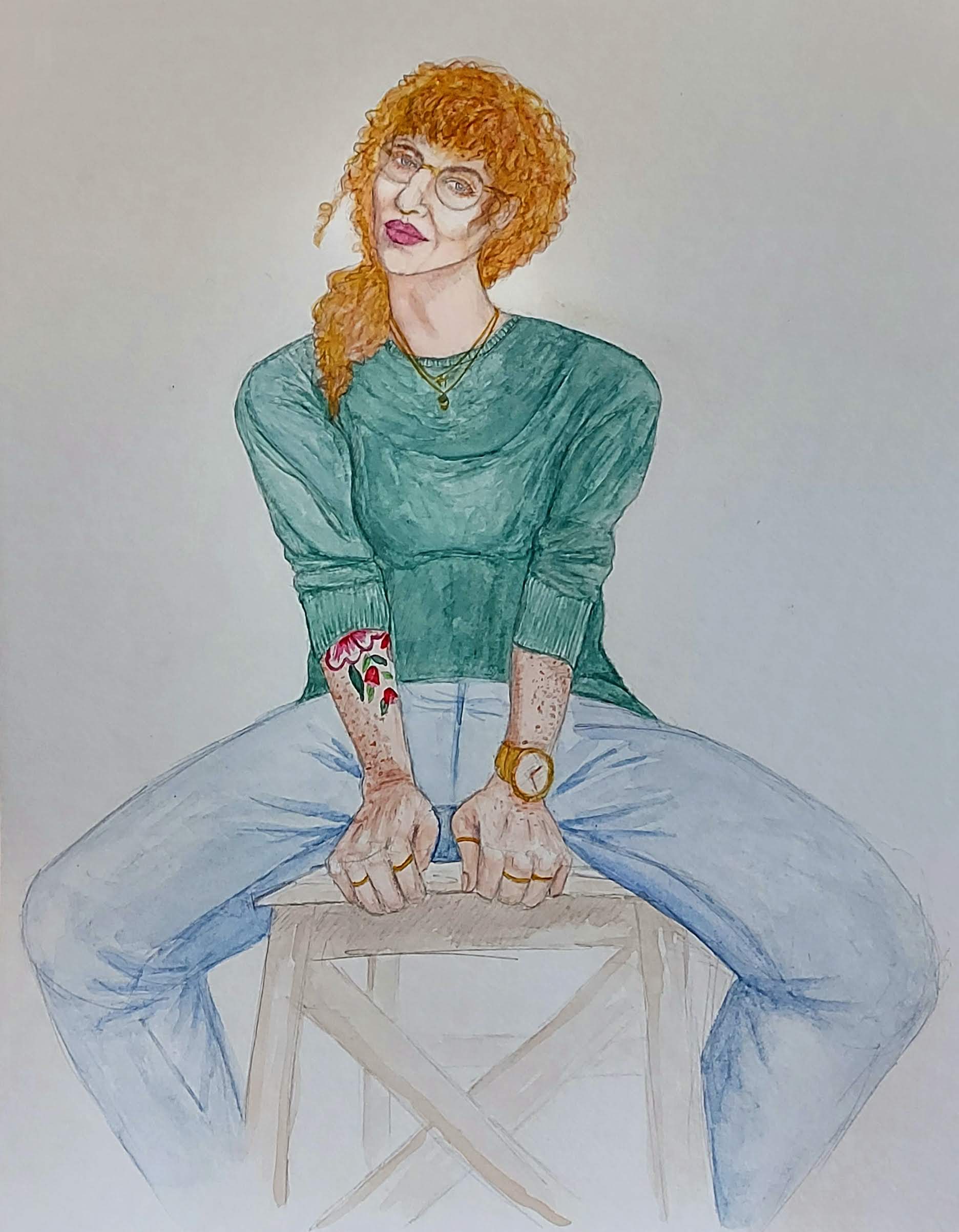Written and Illustrated By Neta J. Rose.
Recently, I’ve been doing these speedwriting exercises. Every morning, I pick up my copy of Patricia Wilson’s beautiful Musings from the Bunker, and let it fall open to a random page to find a prompt for that morning’s story or poem.
Today, I read Patricia describing how, as a young child, she was once correctly gendered by a young mother on the street. “Oh what a beautiful little girl! Why don’t you let her hair grow?” – to which Pat’s father snapped back, “that’s my son and he’s a boy!”
Reading this, old memories start bubbling up in me.
These are memories of a non-binary kid who was trying their best to navigate gender.
When I was a kid, particularly between the ages of 8-12, I was misgendered all the time. Told by well-meaning middle-aged ladies that I was in the wrong bathroom, called “young man,” asked by other kids, “are you a boy or a girl?”
These memories weren’t buried or forgotten: I talked about them a lot when I first came out as queer, telling them as charming anecdotes, evidence of my early and undeniable queerness. Which they certainly were, but only now am I waking up to them as something more. These are memories of a non-binary kid who was trying their best to navigate gender. And god, I love them for that.
The thing is, I hated being misgendered. I was not, and am not, a boy. Yet I went well out of my way to give people every reason to mistake me for one. I wore only “boys’” clothes – baggy, oversized hand-me-downs in all their early 90’s glory; I cut my hair short, and refused any attempt of hairdressers’ to feminize the style into a pixie cut. No, I want exactly what the boys have.
My mum couldn’t understand it. She never dictated what I should wear – though with strategically-placed eyerolls she would let her opinions be known – but she’d become exasperated when I’d cry about being mistaken for a boy, yet again. Why didn’t I just grow my hair out, then, she’d ask? Let her buy me some clothes from the girls’ section?
If I hated being mistaken for a boy, why didn’t I change something so I looked more like a girl? I had absolutely no answer.
When this persisted into middle school, the question became, “why don’t you let me show you how to put on a little make-up?” I eventually did, but the early introduction to mascara and eyebrow-pencil led to a decades-long battle with myself to finally believe it was perfectly okay to leave the house with my naturally light-blonde brows and lashes. But as far as the rest of it, she was right to ask. If I hated being mistaken for a boy, why didn’t I change something so I looked more like a girl?
I had absolutely no answer.
When I was about twelve, my mum and aunt and I drove to St. Catharines for my cousin’s bar mitzvah. They had taken this formal event as the excuse they’d been waiting for. A few days before the party, they had marched me into the mall, parked me in a Le Chateau, and announced that it was time for me to get some “appropriate” clothing. With complete glee, they had kitted me out in a long black velvet skirt, a red and black long-sleeved shirt with a glittering silver dragon on it, and platform mules with an embroidered silk strap. As their final triumph, they’d had the salesperson snip off my greying hemp choker, which I’d previously refused to part with.
My mum and aunt love reminiscing about it to this day – the moment they finally shoved me begrudgingly across the threshold from grotty tomboy to burgeoning young woman.
What I really found in that brightly lit dressing room, with mall-rock blasting all around, was the fun of dressing up like a girl.
Now, these two are not monsters. If I’d been miserable in the new clothes, they would absolutely not have forced me to wear them. No, I loved the new look, and that’s why they considered it an unqualified win. They felt they’d made me see what I’d been stubbornly determined to miss: the joys of being a girl.
And I, at twelve, couldn’t even explain it to myself, so how could I have told them? What I really found in that brightly lit dressing room, with mall-rock blasting all around, was the fun of dressing up like a girl.
I wonder if my mum and aunt have thought about that day since I came out as non-binary? I wonder if they feel guilty, or fear that they had somehow hindered me growing into my identity, resulting in this late-in-life uncovering of my true gender? Or if they stay up at night, agonizing over whether they were unwitting agents of transphobia in my formative years?
Probably not.
And they shouldn’t.
Everything was true all at once then, and it still is.
I feel most like myself when I wear “mens’” clothes: I feel completely at home and sexy and confident in these clothes. But I’m not a man. I love getting fully femmed up for special occasions: I’ll revel in shaving my legs for once, wearing heels, putting on all the make-up and jewelry. Getting into the fabulous costume of “being a woman,” but I’m not a woman.
Was it really just my short hair that made me so confusing? Or were strangers picking up on something about me that I didn’t even know yet?
My mum used to promise me that the misgendering as a boy would stop when I hit puberty and grew boobs and hips. And it did, though puberty came late, and my figure isn’t really all that feminine to this day… The truth is that as a young teen I just started having fun dressing as a girl, and people took their cues from that.
These days, I’ve returned to an all-menswear wardrobe, yet I’m consistently read as a woman, because I keep my hair long, and wear lipstick every day. I don’t mind. I know I am non-binary, and this is my happy place: balancing masculine and feminine both inside and outside, I am most myself.
But back then, was it really just my short hair that made me so confusing? Or were strangers picking up on something about me that I didn’t even know yet?
“Are you a boy or a girl?”
Yes.
About The Author
Neta J. Rose (they/she) is a white, Ashkenazi Jewish, queer, non-binary tomboy-femme redhead nerd.
They live and work in Toronto, Canada, the traditional territory of the Anishinaabe, the Haudenosaunee, the Wendat, and the Mississaugas of the Credit River, part of the Dish with One Spoon Wampum Belt Covenant. Toronto is known in Mohawk as Tkaronto – “Where the Trees are Standing in the Water”.
Neta is an actor, painter, poet, and theatre producer. They write
every morning, draw every night, perform whenever they can, and spend
whatever time is left trying to earn some money to pay rent.
If you liked their story and want to chip in for that whole “paying
rent as an artist” thing, tips will be accepted with deep gratitude at
paypal.me/netajeffery1
Follow in IG: @neta.j.rose

